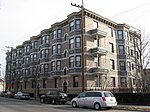WVQC-LP
Community radio stations in the United StatesLow-power FM radio stations in OhioRadio stations established in 2010Radio stations in Cincinnati
WVQC-LP (95.7 FM) is a non-profit, low-power FM radio station in Cincinnati, Ohio, licensed on the frequency 95.7 to Music Resource Center - Cincinnati. The station goes by the name 95.7 MRC Cincinnati’s New Music. The station currently has a construction permit from the U.S. Federal Communications Commission (FCC) and began broadcasting in July 2010. The call letters stand for Voice of the Queen City.
Excerpt from the Wikipedia article WVQC-LP (License: CC BY-SA 3.0, Authors).WVQC-LP
William Howard Taft Road, Cincinnati Walnut Hills
Geographical coordinates (GPS) Address Nearby Places Show on map
Geographical coordinates (GPS)
| Latitude | Longitude |
|---|---|
| N 39.126666666667 ° | E -84.485 ° |
Address
The Alms
William Howard Taft Road
45206 Cincinnati, Walnut Hills
Ohio, United States
Open on Google Maps







